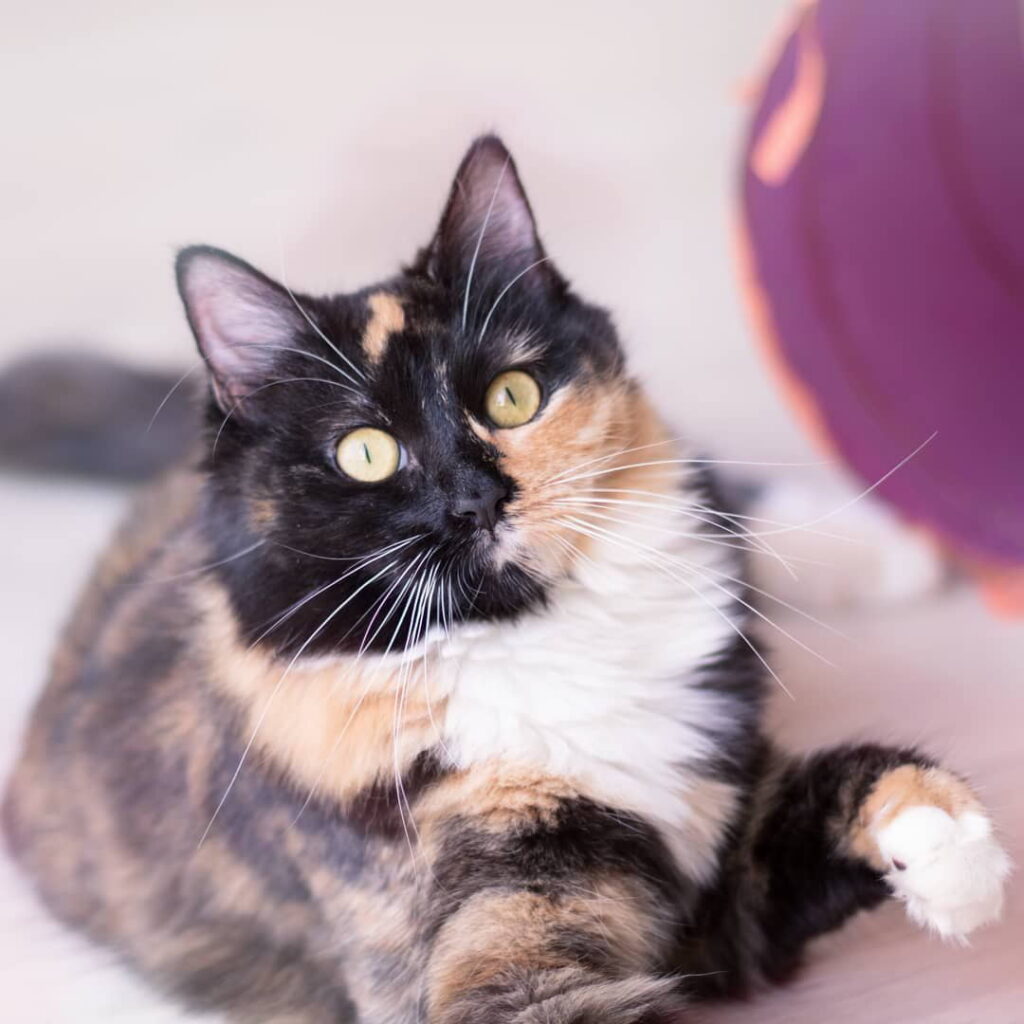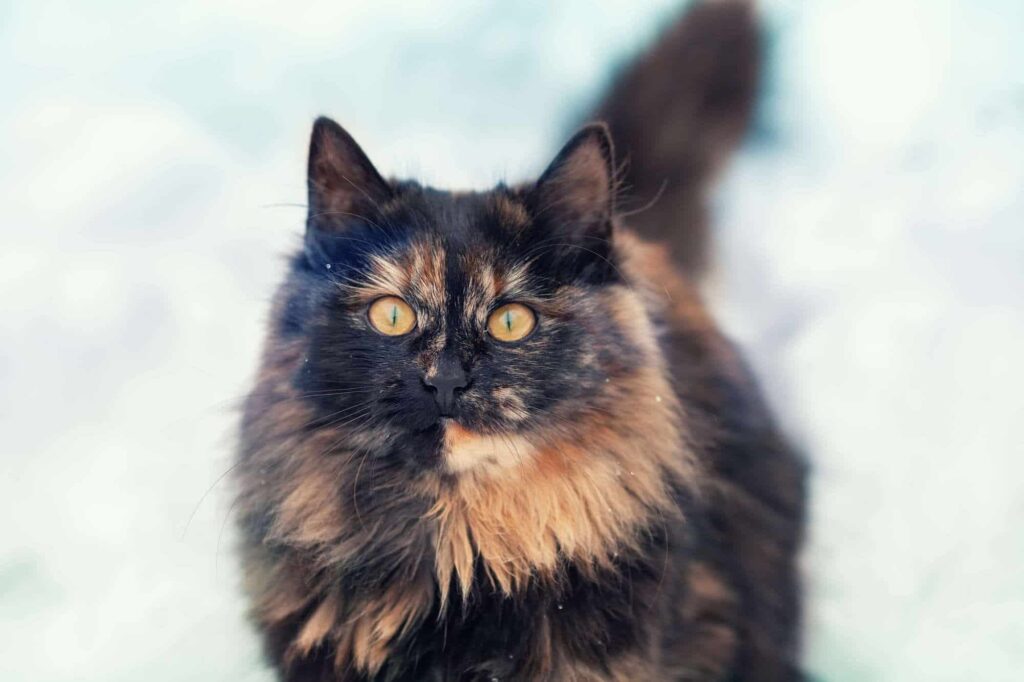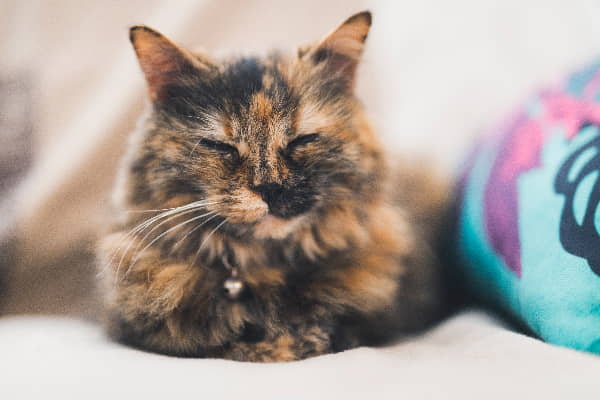The tortoiseshell cat gets its name from its complex colorations. Found in mosaic or chimera, regular or dilute combinations, this cat is so named due to the similarity in color to an once-popular manufacturing material called tortoiseshell. Because the term tortoiseshell, or “tortie” as their fans affectionately dubbed them, refers to the coat, the tortoiseshell cat is not actually a breed.

Tortoiseshells come in a fascinating mix of black hues with browns, oranges and reds sprinkled throughout. But it’s not just their coats that are complex. The tortie has been rumored to be the keeper of feisty “tortitude”-but is it true? We’ll let you be the judge.
This supposed tortitude is only one of many legends surrounding these beautiful felines.From the Celts to the Japanese, the tortoiseshell cat has a history as intricate as their coats! One rumor is untrue, however…some torties are in fact male.
Personality
Calico and tortoiseshell cats are rumored to be a bit feistier than cats of other fur colors, and some research seem to confirm this. But just like the torti’s coat, the feline disposition is far more complex.
There are many factors that can contribute to a cat’s personality, including their breed and upbringing, the researchers were quick to point out. Since tortoiseshell isn’t a breed, it’s hard to generalize their disposition. As a general rule, it’s best to view each cat as an individual and get to know each one personally.

Even if studies report higher levels of attitude in torties, there are many devoted tortie-loving cat parents who avidly claim these cats are truly awesome. Torties have been described as fiercely loyal with their parent, spontaneous and decisive. Fine conversationalists, torties are also not shy in letting their families know what they need.
At the end of the day, “tortitude” may or may not be a thing for this bunch. Sassy or reserved, chatty or observant, these cats have personalities as varied as their coats. Their unwavering dedication to their family is second-to-none so tortitude can be a small price to pay for their heart-melting sincerity and uniqueness.
History
These cats are shrouded in rumors, legends and mystery. They are sometimes known as money cats and are a recognized symbol of good luck within numerous cultures around the world.
The Ancient Celts found fortune with the rare male tortoiseshell. If one spent the night, then the homeowners were bestowed good luck. Japanese fisherman banked on the male tortie’s powers too: they would bring them on board their ships to protect them from apparitions and storms.
Rumor also has it that if you dream of one of these beauties, love will strike.… so, sweet dreams.

Physical Attributes
BODY
A tortie cat has a 1/3000th chance of being male. That means over 99.9% of all tortoiseshell cats are female. The X chromosome of the cat creates the orange and black coat coloring that is the base of a tortie’s coat. Because females have the XX chromosome patterns, their two X’s can become co-dominant and produce a tortie kitty. Since males have the XY chromosomes, they can’t be tortie UNLESS they somehow end up with a genetic mutation and snag another X to then possess an XXY pattern. So, torties are mostly, but not entirely, all gals.
Fur length and paw shape can vary greatly as these cats come in all sorts of breeds. The Maine Coon, Cornish Rex, Persian and Ragamuffin breeds have all sported the striking tortoiseshell fur. But even mixed-breed cats wear this fancy coat, including domestic short, medium and long hairs as well as tabbys-which are often referred to as torbies when their stripes or swirls are mixed with the tortoiseshell color.

Torties whose colors are displayed in larger sections are usually called “patched” while those whose colors interweave are “brindled.” The colors can also be integrated throughout the body (mosaic), or they could be split-one side of the cat’s body is one color and the other is another color. The split could also be between face and body.
The tortie also varies greatly in weight and lifespan., Tiffany Two, a California tortoiseshell cat, was named the currently-oldest living cat in 2015 by the Guinness World Records, at the very respectable age of 26.
Disclaimer
Note: While the characteristics mentioned here may frequently represent this breed, cats are individuals whose personalities and appearances will vary. Please consult the adoption organization for details on a specific pet.
Wondering about Tortoiseshell? Check it out on our next post!
